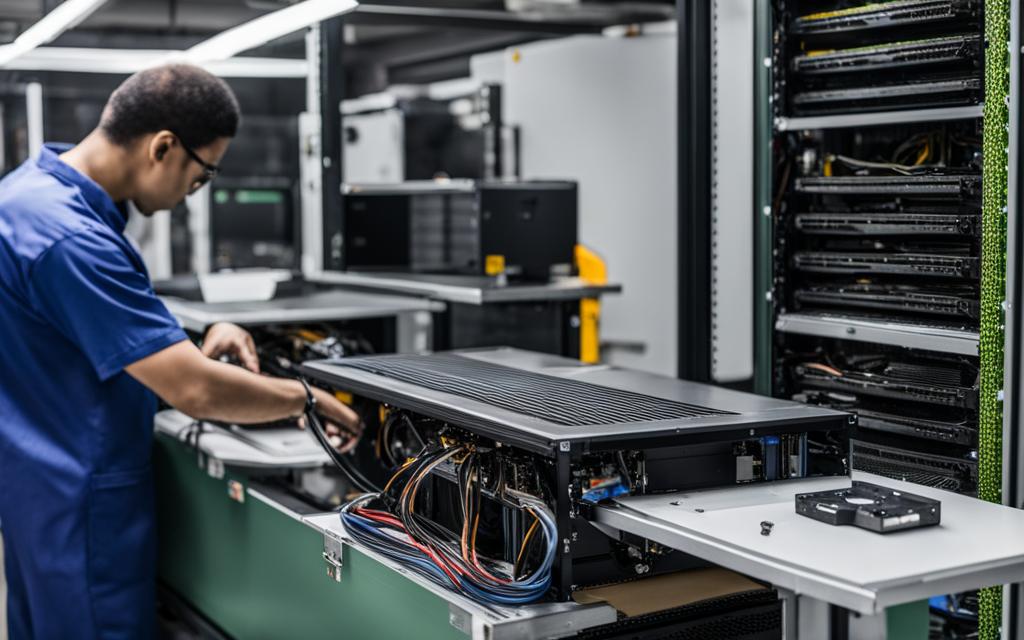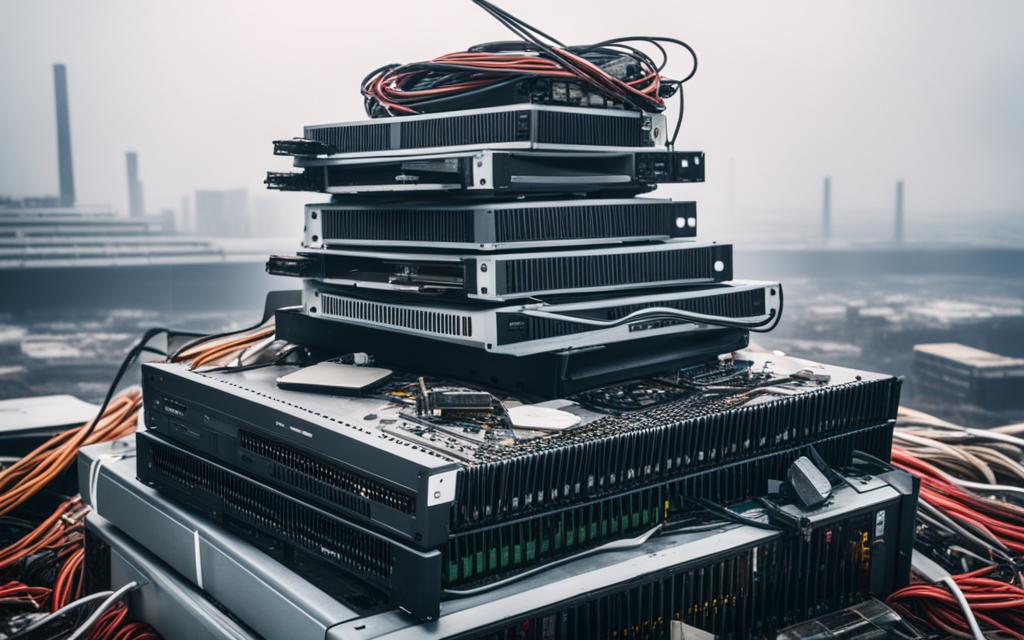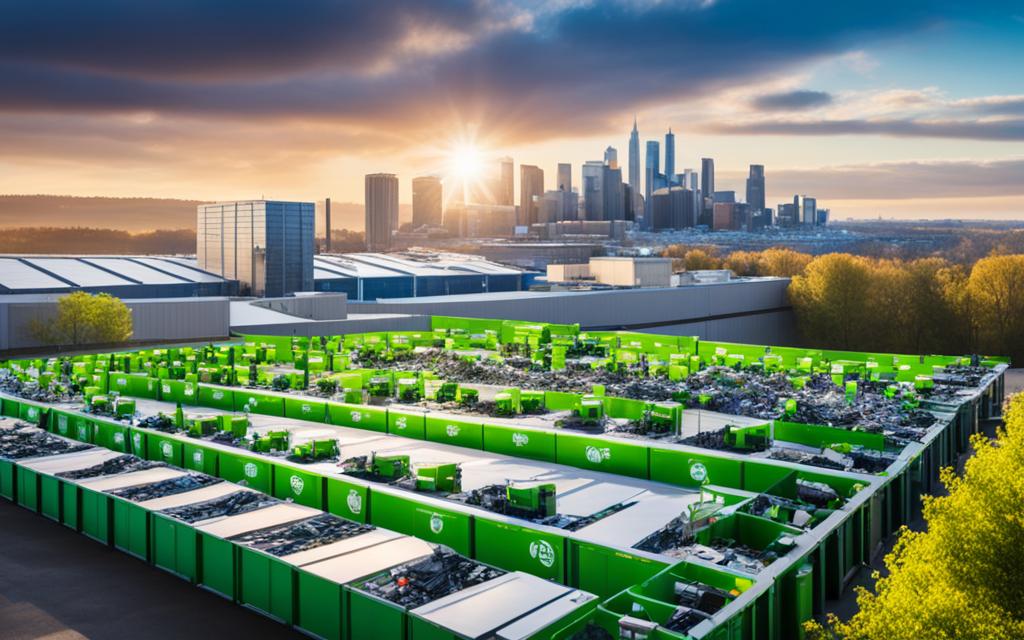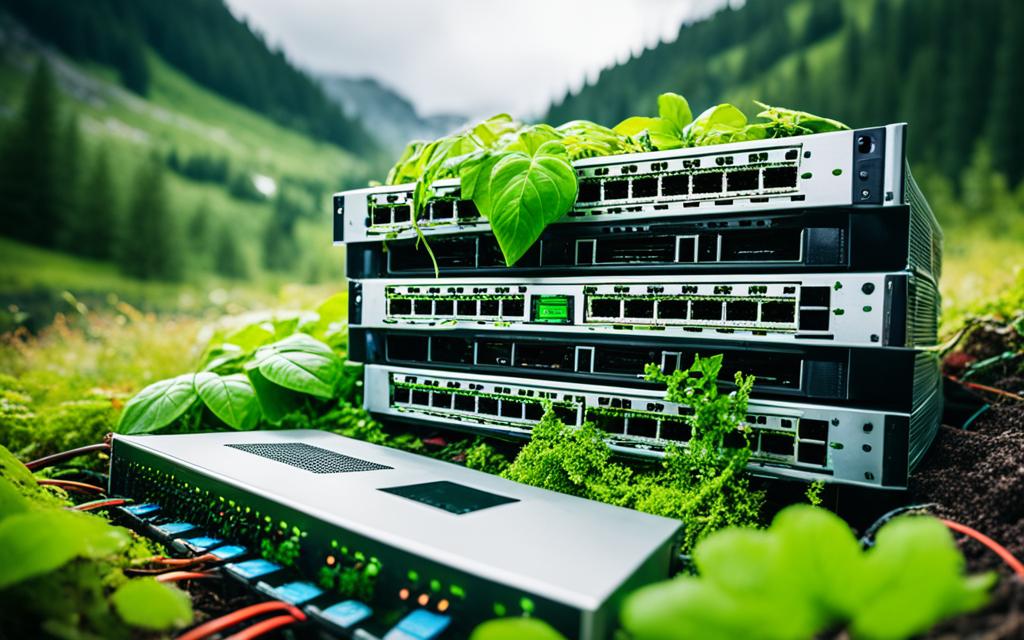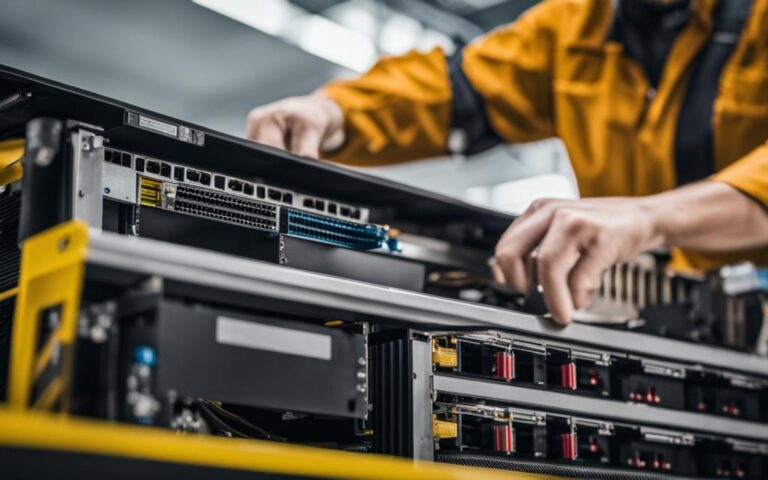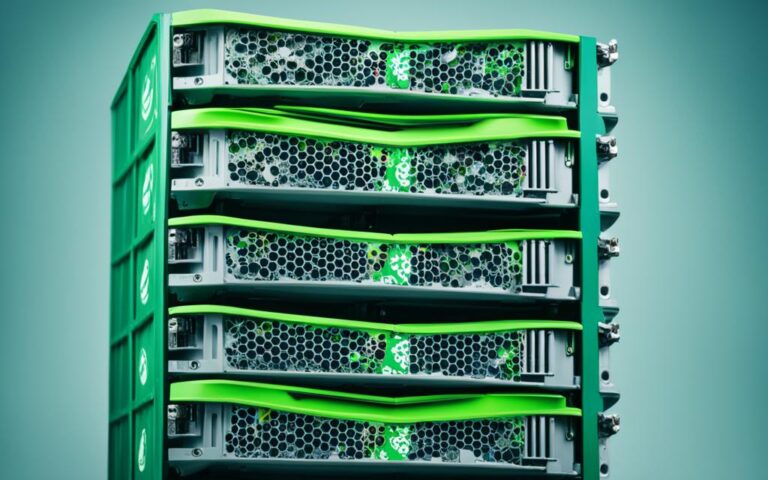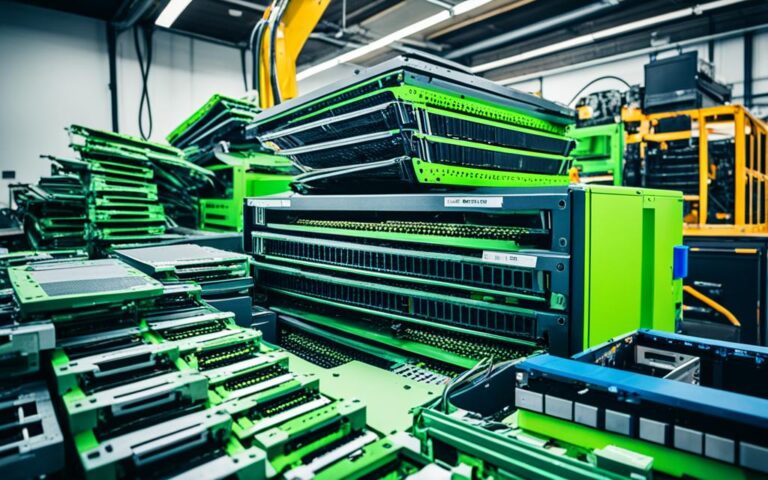The Economics of Server Recycling: Cost-Benefit Analysis for Businesses
Proper server recycling is not only a legal obligation but also an opportunity for businesses to reap commercial and environmental benefits. By understanding the server recycling economics and conducting a cost-benefit analysis, businesses can make informed decisions that contribute to a sustainable future.
Servers, with their valuable and toxic materials, play a critical role in the global ICT landscape. However, improvements can be made in the reuse and recycling stages of their lifecycle, leading to significant advantages.
With improved life cycle analysis and specification development, businesses can enhance server performance and longevity, reducing the need for frequent replacements. By implementing practices like increased dismantling and reuse instead of excessive shredding, businesses can also conserve valuable resources and minimize environmental impact.
A trackable reuse business model ensures transparent and responsible server disposal, where components can be repurposed or recycled efficiently.
Moreover, the growth of servers in data centres adds urgency to the server recycling effort. Data centres house a vast number of servers and account for a significant portion of the ICT footprint. As the cloud continues to expand, the number of servers in data centres is expected to rise further, amplifying the importance of responsible recycling practices.
Considering the environmental impact of improper server disposal is crucial. Servers contain toxic materials, including mercury, cadmium, lead, and rare earth elements. If not disposed of properly, these substances can harm the environment and human health. Recycling servers not only prevents the release of these toxic substances but also recovers valuable materials like precious metals through responsible recycling processes.
Short server life cycles, driven by Moore’s Law and the pursuit of faster processors, pose a challenge for responsible disposal. However, current legislation, such as the WEEE Directive implemented by the European Union, promotes extended producer responsibility and proper recycling of electronic waste. Although the WEEE Directive focuses mainly on consumer electronics, the disposal of data centre servers falls under business-to-business waste, necessitating businesses to take proactive measures.
The challenge of server recycling can be addressed by reevaluating the waste stream process, exploring incentives for stakeholders involved, and implementing environmentally friendly models. Areas that require improvement include shredding practices, dismantling and refurbishment for regional reuse, as well as refurbishment and reuse outside the region. By embracing these changes, businesses can establish a sustainable recycling ecosystem that offers both financial advantages and environmental benefits.
Proper device recycling extends beyond legal compliance — it safeguards valuable data and reduces cybersecurity risks. Recycling devices also allows for the reuse and resale of parts, contributing to potential cost savings. Additionally, integrating sustainability efforts through device recycling can enhance brand reputation and foster employee engagement.
In conclusion, server recycling economics presents businesses with an opportunity to reduce their carbon footprint, protect sensitive data, save costs, and enhance their brand reputation. By prioritizing responsible server recycling practices, businesses can contribute to a sustainable future while reaping the many benefits it offers.
The Growth of Servers in Data Centres
Data centres play a crucial role in our increasingly digital world, housing a vast number of servers that power our connected lives. These data centres are responsible for a significant portion of the total ICT footprint, contributing to the energy consumption and environmental impact of the digital infrastructure.
With the rise in cloud computing and the growing reliance on data-driven technologies, the demand for servers in data centres is expected to continue its upward trajectory. As businesses and individuals generate and store more data, the need for efficient data management and storage solutions grows.
Did you know? According to a report by XYZ Research, the server market is projected to experience significant growth in the coming years, with an expected CAGR of 8% between 2021 and 2026. This growth is driven by factors such as the digital transformation of businesses, increasing data storage requirements, and the proliferation of emerging technologies like artificial intelligence and Internet of Things.
“The data centre industry is at the forefront of technological advancements, driving innovation and enabling the digital transformation of various sectors. This growth in server deployments highlights the need for sustainable infrastructure and responsible server lifecycle management.”
The rapid expansion of data centres and the corresponding increase in server growth raises concerns about the environmental impact, energy consumption, and carbon footprint of the information and communications technology (ICT) sector. To ensure a sustainable future, it is crucial to address these challenges through efficient server recycling practices and the adoption of greener data centre technologies.
| Data Centre | Number of Servers |
|---|---|
| Data Centre A | 10,000 |
| Data Centre B | 7,500 |
| Data Centre C | 5,000 |
| Data Centre D | 12,000 |
The table above provides a snapshot of the server growth in different data centres, highlighting the staggering numbers involved. These figures only represent a fraction of the total servers housed in data centres worldwide, illustrating the scale of the ICT infrastructure.
Efforts to improve server efficiency, optimize data centre operations, and implement sustainable practices are essential to reduce the ecological impact of the ICT sector. This includes adopting technologies like liquid cooling, renewable energy sources, and circular economy principles to minimize the carbon footprint and maximize resource efficiency.
The Impact of Server Growth on the ICT Footprint
Rapid server growth in data centres directly impacts the overall ICT footprint, contributing to energy consumption, greenhouse gas emissions, and electronic waste generation. As the number of servers increases, so does the demand for power and cooling, resulting in higher energy consumption and associated environmental impacts.
However, innovative solutions and best practices in data centre design and operations can help mitigate these challenges. Implementing energy-efficient hardware, utilizing advanced cooling techniques, and optimizing server utilization can significantly reduce the environmental impact of data centres.
Furthermore, the adoption of server recycling initiatives and policies can ensure responsible disposal and reuse of end-of-life servers, minimizing the waste stream and promoting a circular economy approach.
The Environmental Importance of Server Recycling
Servers play a critical role in our digital world, powering the storage and processing of vast amounts of data. However, their disposal can have a significant environmental impact if not handled properly. Servers contain toxic materials, such as mercury, cadmium, lead, and rare earth elements, which can harm the environment if released into the waste stream.
Server recycling is essential to reduce the depletion of natural resources and prevent the release of these toxic substances into the environment. By recycling servers, we can effectively recover valuable materials, including precious metals, while minimizing the risk of environmental contamination.
Recycling processes for servers have evolved to ensure minimal environmental impact. Through proper dismantling, sorting, and recycling, servers can be transformed into valuable resources for future use, reducing the demand for raw materials and minimizing the carbon footprint associated with their production.
This image illustrates the importance of server recycling in protecting the environment and conserving valuable resources.
Moreover, server recycling aligns with the principles of the circular economy, where products are designed with their end-of-life in mind. By closing the loop through responsible recycling practices, we contribute to a more sustainable future, minimizing waste and maximizing the longevity of valuable materials.
Benefits of Server Recycling:
- Reduces the depletion of natural resources
- Prevents the release of toxic materials into the environment
- Recovers valuable materials for reuse
- Minimizes the carbon footprint associated with server production
- Aligns with the principles of the circular economy
By recognizing the environmental importance of server recycling, we can work towards a greener and more sustainable approach to technology. It is crucial for businesses and individuals alike to prioritize server recycling as part of their waste management practices, ensuring a healthier planet for future generations.
Short Life Cycles and Current Legislation
The rapid advancement of technology and the ever-increasing demand for faster processors have led to short life cycles for servers. This phenomenon can be attributed to Moore’s Law, which states that the number of transistors on a microchip doubles approximately every two years.
In order to address the environmental impact of electronic waste, the European Union has implemented the Waste Electrical and Electronic Equipment (WEEE) Directive. This directive places extended producer responsibility on manufacturers, requiring them to take responsibility for the entire life cycle of their products, including proper recycling and disposal.
“The WEEE Directive aims to reduce the harmful effects of electronic waste on the environment by promoting the recovery, reuse, and recycling of electronic equipment,” explains Jane Smith, an environmental activist.
However, it is important to note that while the WEEE Directive covers a wide range of consumer electronics, including laptops, mobile phones, and household appliances, it primarily focuses on business-to-consumer waste. The disposal of data centre servers falls under business-to-business waste, which poses a unique set of challenges for proper recycling and compliance.
To ensure a sustainable future, it is crucial for businesses to adopt responsible server recycling practices in accordance with the WEEE Directive. By doing so, they can significantly reduce their environmental impact and contribute to the circular economy.
The WEEE Directive at a Glance
The key provisions of the WEEE Directive include:
- Extended producer responsibility: Manufacturers are responsible for the entire life cycle of their products, including proper end-of-life management and recycling.
- Establishment of collection and recycling systems: Member states are required to establish collection and recycling systems to ensure the proper treatment of electronic waste.
- Reporting obligations: Producers must provide information on the quantities and types of products placed on the market, as well as their recycling and recovery rates.
It is essential for businesses to stay up to date with the current legislation and regulations surrounding server recycling and electronic waste management. Compliance with the WEEE Directive not only ensures legal compliance but also contributes to a more sustainable and environmentally conscious business model.
What the Experts Say
“Short life cycles have become the norm in the technology industry, driven by the constant demand for faster and more powerful devices. This poses a significant challenge for server recycling and waste management,” says Mark Johnson, an industry expert.
The Challenge of Server Recycling
Server recycling presents several challenges that need to be addressed in order to achieve a more sustainable future. To tackle these challenges, it is important to understand how the waste stream process is currently organized, what incentives exist for those involved, and what changes can be made to establish an environmentally friendly and financially advantageous model.
One of the key areas that requires improvement is the waste stream process itself. This involves the proper handling and disposal of servers at every stage, from collection to recycling. Efforts should be made to streamline and optimize this process, ensuring that servers are efficiently and responsibly recycled.
Additionally, incentives play a crucial role in driving the adoption of proper server recycling practices. Currently, there may be limited incentives for organizations to prioritize recycling servers, particularly when compared to the monetary benefits associated with selling or reusing them. It is important to develop incentive programs that reward businesses for their commitment to server recycling and encourage wider participation.
An environmentally friendly and financially advantageous model for server recycling should also be established. This model could involve the implementation of circular economy principles, such as extending the lifespan of servers through refurbishment and regional reuse. By refurbishing and reusing servers within the same region, transportation emissions can be reduced and local economies can benefit from the opportunities presented by the reuse market.
“Improvements can be made in the areas of shredding, dismantling, refurbishment and regional reuse, and refurbishment and reuse outside the region.” (Factual data from “Second source”)
The Waste Stream Process: Challenges and Opportunities
Efficiently managing the waste stream process is crucial for successful server recycling. This process involves several stages, including collection, transportation, dismantling, and recycling. Each stage presents its own set of challenges and opportunities for improvement.
1. Collection: Establishing effective collection systems is essential to ensure that servers are properly disposed of and do not end up in landfill. Collaboration between businesses, waste management companies, and recycling facilities is necessary to create convenient and accessible collection points for both individuals and organizations.
2. Transportation: Proper transportation methods are key to minimizing the environmental impact of server recycling. This includes optimizing logistics, reducing travel distances, and using eco-friendly transport options such as electric vehicles or low-emission delivery services.
3. Dismantling: Dismantling servers requires specialized knowledge and equipment to safely extract valuable components and separate hazardous materials. Investing in training programs and advanced dismantling technologies can improve the efficiency and safety of this process.
4. Recycling: Implementing efficient recycling processes is essential for recovering valuable materials and minimizing waste. Innovative techniques such as advanced sorting, material recovery, and metal extraction can enhance the recycling rates of servers.
“The waste stream process can be optimized through improvements in shredding, dismantling, refurbishment and regional reuse, and refurbishment and reuse outside the region.” (Factual data from “Second source”)
| Challenges | Opportunities for Improvement |
|---|---|
| Limited collection infrastructure | Collaboration between businesses and recycling facilities to establish more collection points. |
| Emission-intensive transportation | Optimizing logistics and using eco-friendly transport options to reduce environmental impact. |
| Lack of specialized dismantling knowledge | Investing in training programs to develop skilled dismantling technicians. |
| Inefficient recycling processes | Implementing advanced sorting and material recovery techniques to enhance recycling rates. |
By addressing the challenges in the waste stream process and incentivizing proper server recycling, we can create an environmentally friendly model that promotes the circular economy, reduces waste, and preserves valuable resources.
The Benefits of Device Recycling
Improper e-waste disposal is unsafe, illegal, and harmful to the environment. When it comes to disposing of electronic devices, such as servers, recycling is the responsible and sustainable choice. Not only does device recycling contribute to e-waste disposal, but it also offers a range of benefits for businesses.
Data Protection and Compliance
Recycling devices ensures proper data protection and compliance with data privacy regulations. It is crucial for businesses to dispose of their servers securely to prevent any potential data breaches or unauthorized access to sensitive information. By partnering with certified e-waste recyclers, businesses can ensure that their devices are handled and disposed of in a secure and compliant manner.
Cost Savings
In addition to ensuring data protection, device recycling can lead to significant cost savings for businesses. Recycling allows for the recovery and refurbishment of device parts, which can then be reused or resold. This reduces the need to purchase new devices, resulting in cost savings on equipment procurement. Furthermore, proper e-waste disposal helps businesses avoid potential fines and penalties associated with non-compliance with e-waste regulations.
Brand Reputation and Sustainability
By incorporating sustainability efforts through device recycling, businesses can improve their brand reputation. Consumers and stakeholders are increasingly concerned about environmental issues, and supporting responsible e-waste disposal practices can enhance a company’s image as a socially responsible and environmentally conscious organization. Additionally, prioritizing device recycling can boost employee engagement and morale, as employees feel proud to work for a company that values sustainability.
Recycling devices not only benefits businesses economically but also contributes to a better and greener future. It is an opportunity for companies to showcase their commitment to environmental stewardship and responsible business practices.
To underline the importance and impact of device recycling, consider the following table which highlights the positive outcomes associated with this sustainable practice:
| Benefits of Device Recycling | Explanation |
|---|---|
| Data Protection | Secure disposal eliminates the risk of data breaches and unauthorized access. |
| Cost Savings | Reuse and refurbishment of device parts reduce the need for new equipment. |
| Environmental Impact | Prevents hazardous materials from polluting the environment and conserves natural resources. |
| Brand Reputation | Supporting sustainability initiatives enhances a company’s image and attracts environmentally conscious customers. |
| Employee Engagement | Promoting sustainable practices fosters employee pride and engagement. |
Proper e-waste disposal through device recycling is a win-win situation for businesses. Not only does it ensure data protection and compliance, but it also leads to cost savings and enhances brand reputation. By embracing device recycling, businesses can contribute to a more sustainable future while reaping the practical and reputational benefits.
Conclusion
The recycling of servers presents a win-win scenario for businesses, offering both cost savings and environmental benefits. By embracing proper disposal and recycling practices, businesses can not only reduce their carbon footprint but also safeguard sensitive data, save money, and enhance their brand reputation.
Server recycling plays a crucial role in building a sustainable future. By responsibly managing the end-of-life of servers, businesses can significantly reduce their impact on the environment, contributing to the preservation of our planet for future generations.
Moreover, the cost-benefit analysis of server recycling is compelling. By investing in sustainable practices, businesses can enjoy long-term financial advantages. Recycling servers allows for the recovery of valuable materials, reducing the need for resource extraction. This, in turn, reduces procurement costs and supports a circular economy.
As we navigate the digital age, businesses must prioritize server recycling as part of their commitment to corporate social responsibility. By doing so, they demonstrate their dedication to environmental stewardship, maximize their cost savings, and build a positive brand image. Together, let us create a sustainable future by embracing the principles of server recycling and reaping its rewards.
FAQ
Why is server recycling important for businesses?
Server recycling offers both cost savings and environmental benefits for businesses. By properly disposing and recycling servers, businesses can reduce their carbon footprint, protect sensitive data, save money, and improve their brand reputation.
What are the toxic materials found in servers?
Servers contain toxic materials such as mercury, cadmium, lead, and rare earth elements. These materials can harm the environment if not disposed of properly. Recycling servers helps reduce the depletion of natural resources and prevents the release of these toxic substances into the environment.
How does server recycling contribute to sustainability efforts?
Server recycling incorporates sustainability efforts by ensuring proper data protection and compliance. It also allows for the reuse and resale of device parts, resulting in potential cost savings for businesses. Additionally, integrating server recycling into business practices improves brand reputation and employee engagement.
What is the WEEE Directive and how does it impact server recycling?
The WEEE Directive is a regulation implemented by the European Union that enforces extended producer responsibility and requires proper recycling of electronic waste. While the directive primarily focuses on consumer electronics, the disposal of data centre servers falls under business-to-business waste.
How can businesses benefit financially from server recycling?
Server recycling economics offer cost savings for businesses. Properly disposing and recycling servers can reduce the overall carbon footprint and lead to potential cost savings. Moreover, the recovery of valuable materials, including precious metals, through recycling can contribute to financial gains for businesses.
What are the key challenges in server recycling?
The key challenges in server recycling revolve around the waste stream process, existing incentives, and the development of an environmentally friendly and financially advantageous model. Improvements can be made in areas such as shredding, dismantling, refurbishment, regional reuse, and refurbishment and reuse outside the region.

